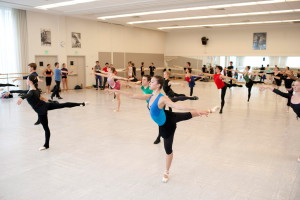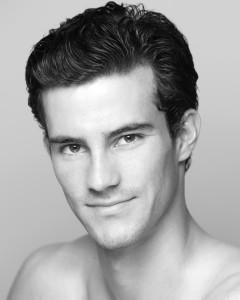At the age of three, Alexandra McCullagh Newman saw her first Nutcracker— immediately, she was in love. Fast forward a few years, and McCullagh Newman was well-immersed in the dance world, taking class six days a week at Marin Ballet. She and her mother were also loyal San Francisco Ballet season ticket holders, attending Sunday matinées during the regular season. Unlike many pre-professional ballet dancers, this Bay Area native had a fairly typical childhood and adolescence: she lived at home, trained at nearby studios and attended regular high school. And as graduation neared, so did decision time. Would college be the next chapter? A company? If it was to be the latter, she hoped that San Francisco Ballet might be part of the picture. It was the company she knew, the company she had grown up watching and the one major ballet company that was close to home. To her delight, everything came together beautifully. In 2006, McCullagh Newman was offered a position in the San Francisco Ballet’s corps de ballet, “it was like I won the lottery; an opportunity to dance with a great company and still be near my family and friends.”

© Erik Tomasson
Gaetano Amico III relocated from Oregon to Northern California in order to attend the prestigious San Francisco Ballet School. A big, dramatic change for any teenager, he was now on his own in a new city, a state away from his home and family. Ballet training at the San Francisco Ballet School was serious, intense and challenging, requiring total commitment and significant sacrifice. And all his dedication, time and attention certainly paid off. Amico was chosen to participate in the School’s newly established Trainee Program—a unique pre-professional curriculum (then in its infancy but currently in its ninth year) designed to bridge the gap between student life and company life. Upon completing the Trainee Program in 2006, Amico was one of the few to be awarded an apprenticeship in the San Francisco Ballet. He recalls that life-changing phone call, “Helgi Tomasson wanted to take a chance on me; I was hired, I was an apprentice.” The year he spent as an apprentice was not only one of the busiest seasons in his life, but also incredibly exciting, “I was finally working in a ballet company; something that I had been wanting for so long.” And in 2007, Amico was subsequently promoted to the corps de ballet.
Two different dancers; two different stories; two different pathways. Varied routes can lead to the same place. A little cliché, but very true. And now years later, after many seasons with the San Francisco Ballet, both McCullagh Newman and Amico are long-time, senior members of the corps.
If you are one of the lucky few who make it into a sizable ballet company, the corps de ballet is likely where you will start and maybe where you will stay. Within the infrastructure of every major company, this group of dancers is integral to the entire ballet canon. Without them, ballet as we understand it today would look very different. Epic narrative ballets need bustling ballroom scenes and wistful winter sequences. Even modern works sometimes require a large cast, a portion of who will be from the corps. Many choreographic styles and genres use the corps de ballet: full-length traditional stories, abstract neo-classical compositions and contemporary de-constructed ballets.

© David Allen
To the casual ballet fan, the corps de ballet can scream of homogeneity. Yes, certain ballets (some of the more famous and popular ones) do require precise uniformity where every port de bras, épaulement angle and extension must be exactly the same. But that is only one small part of the corps de ballet story; one aspect of the job. Flexibility is both a literal and figurative requirement if you are to be a member of the corps, especially in the San Francisco Ballet. In fact, with the varied responsibilities they hold in both rehearsal and performance, the corps de ballet may be more about diversity than they are about sameness. Assistant to the Artistic Director and Ballet Master Ricardo Bustamante relays, “Helgi is interested in finding talented dancers who are not duplicates of other corps members but who can bring their own assets to enrich the company. These dancers must be chosen carefully because a good corps is precious to a company— they are the core of it, so to speak.”
Perhaps the one constant in the corps de ballet schedule is morning technique class. For an hour and fifteen minutes every day, each dancer gets to prepare their instrument, challenge their technique and push their boundaries. For some, morning class can be a time for experimentation. For others, it is like a meditative prayer—a time to cycle through familiar exercises, carefully work through injuries and quiet your mind for what comes next. Whichever approach you take to class, every member of the corps de ballet can attest to the following reality: rehearsals and performances are on the horizon, and they need to be ready for anything.
First and foremost, time in the studio is very diverse for the corps. From a purely logistic standpoint, rehearsal schedules change from day to day, based on casting and upcoming performance commitments-corps members may be needed for an hour one day and then required for six hours the next. Senior corps members like McCullagh Newman and Amico have learned how to make the most of their downtime and maximize every free moment. In addition to their professional ballet careers, both dancers are pursuing a Bachelor of Arts degree through the St. Mary’s College of California’s LEAP program. Amico notes that juggling a full-time career and school is all about time management, “in my free time, I either catch up on school work, study for rehearsal or exercise—I don’t allow one minute to go to waste.” Though both have also used breaks in their schedule to rejuvenate their mind and body with a quick nap!
During rehearsals, choreography is learned and repertory is perfected in preparation for performance. But peer guidance is also part of the picture for the seasoned corps de ballet dancer. Amico explains that as part of the senior corps, “you have an opportunity to engage with the younger dancers, to be an example for them and to help them learn.” McCullagh Newman calls it a type of ‘big sister’ relationship, “if you want to, you can choose to walk alongside the new dancers…you know what it’s like to be where they are; to be intimidated to ask questions; to not know the unwritten rules of the company.” She adds, “when I was new, I was so fortunate to have people like Dores André and Clara Blanco guiding me—now I get to continue that encouraging environment and that special coaching.”
Though San Francisco Ballet has a fairly traditional ranking system (principals, principal character, soloists, corps de ballet, apprentices), the company’s casting process enjoys a remarkable fluidity. Artistic Director Helgi Tomasson and the entire creative team are committed to fostering growth and cultivating talent at every level. As Bustamante describes, “we are an active company and it’s important that we spread the wealth in terms of opportunities to dance. Helgi doesn’t just collect good dancers— he wants to see them on stage.” To that end, corps dancers in this company may be cast in more prominent and featured roles in addition to the expected swans, villagers and flowers. For McCullagh Newman, this is one of the reasons why being in San Francisco’s corps de ballet is so fulfilling, “here, you can be in the corps and you can grow as an artist.” A great example is last season when Amico was handpicked to dance one of the Fates in Christopher Wheeldon’s new Cinderella, which incidentally returns next year as 2014’s fourth program.

© David Allen
And so, the stage can afford great diversity for members of the corps de ballet. During the regular season, the corps may dance two to three ballets in one night, sometimes with classical and contemporary repertoire back-to-back on the same program. While dancing multiple works from different genres certainly requires incredible stamina and mental acuity, it also strengthens their physical vocabulary, enriches their choreographic capabilities and builds their own personal repertory. When it comes to narrative story ballets, the corps may find themselves interpreting a plethora of different roles: delicate fairies, rowdy townspeople, robust soldiers or gallant courtiers. Each requires a distinctive movement style and significant attention to character development. “A strong, versatile corps gives you freedom to try all sorts of different repertory, says Bustamante, “so for instance with SFB, we’re able to do the more classical works very well but because the company—including the corps—is so versatile, we can also perform more experimental or modern work well.”
Clearly, being part of the corps de ballet is a broad, creative experience of unique artistic diversity. Amico shares, “I wake up everyday, excited to come to work because I get to interact, mingle and collaborate with a welcoming, approachable, open-minded, dedicated group of people.” But beyond the barre, the studio and the stage, Amico knows that his time in the San Francisco Ballet has instilled lasting lessons and invaluable knowledge, “the life skills and maturity that you gain by being in this company are priceless, they can be translated into any post-dancing profession that I may choose; that is a real blessing.”
To learn more about San Francisco Ballet, 2013 Nutcracker performances and their upcoming 2014 season, please visit: sfballet.org
This article appeared in the September 2013 issue of In Dance.

